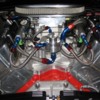If you can get over the idea of keeping the stock engine screen or modifying it some, then it would be very easy to adapt a single plane spider manifold to EFI without doing anything to the stock hood. One of those TFS manifolds has the bosses for injector bungs from what I saw. There are people out there who will fabricate fuel rails for a single plane intake regardless if it has the injector bungs cast into the manifold or not.
http://www.hotrodsolutions.net/EFI2.htmlWilson Manifolds also does the conversion. I was quoted between 450-650 for this work.
They have plenty of throttle plates that adapt over a 4150/4500 flange or you can run a 4150/4500 elbow and then a traditional 5.0 mustang 90mm throttle body from someone like Wilson or Accufab or BBK w/e. Run an elbow that routes the conical air filter back under the decklid somewhere. Tap some holes in either the manifold, the elbow etc for vacuum provision and reference for the various efi sensors.
It's the same process guys have done getting 351w 9.5 deck motors into mustangs under stock hoods for years.

You don't have to use a TFS EFI manifold to have an injected cleveland. There are a lot of routes you can go.
Here is an elbow that sits even lower and helps clear a fuel rail.
 http://www.6061.com/50mustangelbow.htmhttp://www.cantedvalves.com/efi1.php
http://www.6061.com/50mustangelbow.htmhttp://www.cantedvalves.com/efi1.phpJust find a single plane that matches your heads. Single planes that have bosses which can be drilled out for fuel rails include TFS, AFD, CHI 3V, Parker Funnelweb, some Edelbrock etc. Someone would still need to drill out the correctly spaced opening on the fuel rails and weld some kind of stanchion to support the rail. Or just have someone do the whole process like indicated above to weld the bung and drill it out which opens up the intake availability to practically any single plane including used Holley Strip/Street Dominators, Weiand, SVO/Yates Intakes, Blue Thunder, Edelbrock, Sheetmetal, etc.
Figure
-2500 for standalone ECU+all sensors
-400 for EFI fuel pump, regulator, lines.
-900 for a converted intake with correctly sized injectors and rails included
-400-700 for throttle body
Obviously you can do better than this depending on what system you go with and whether you get stuff used and how much you get for your old carb related parts. Ford EEC out of a wrecked 5.0, holley commander, fast XFI, AEM, electromotive, haltech, bigstuff3, megasquirt, accel gen7, motec (bend over US customers), EFI Technology, sequential, b2b, batch. If you go with the Ford EEC, then you have to get some piggyback chip to program it and then have correct size Mass air flow meter.
http://www.accufabracing.com/4_barrel.htmhttp://www.wilsonmanifolds.com...cts/throttle-bodies-http://www.summitracing.com/se...Bodies/?autoview=SKUThe Walbro GSS392 is a good inline high flow EFI pump that is quiet for everyday street use. I've used SX aerospace certified pumps and they are loud. some other stuff like aeromotive can overheat with street use. Weldon makes really nice stuff as well but much of it is drag race oriented.
http://www.fuelsystems.bizYou can do everything from a Hodge Podge junkyard 5.0 EFI setup to a fully programmable Windows EFI setup with billet fuel injected pieces on various budgets and you don't need the TFS EFI Intake to do it.





